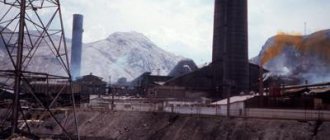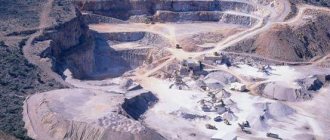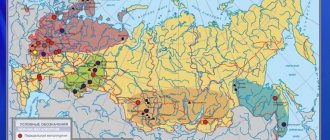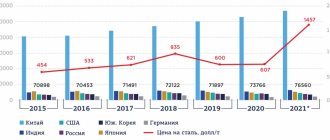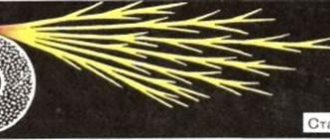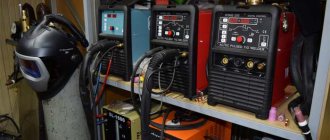Any state strives to develop its economy and increase its defense capability. To solve these problems, machines, equipment, military and civilian equipment, aircraft, and sea vessels are needed. The engineering industry is engaged in the production of machinery and equipment. The raw materials for the manufacture of mechanical engineering products are ferrous and non-ferrous metals.
Therefore, the metallurgical industry, which provides all others with raw materials, is the basis for the well-being of the state in the economic sphere and in maintaining defense capability.
Introduction
In modern conditions of the international division of labor, one of Russia’s specialization sectors is the national metallurgical industry. The metallurgical complex includes ferrous and non-ferrous metallurgy: a set of interconnected industries and stages of the production process from the extraction of raw materials to the production of finished products - ferrous and non-ferrous metals and their alloys. The state and development of the metallurgical industry ultimately determine the level of scientific and technological progress in all sectors of the national economy. The specific features of the industry are the scale of production and the complexity of the technological cycle, which is incomparable with other industries.
Ferrous metallurgy is one of the most important basic branches of heavy industry. Its products serve as the basis for the development of mechanical engineering (one third of the metal produced goes into mechanical engineering), construction (1/4 of the metal goes into construction), and metalworking. In addition, ferrous metallurgy products are of export importance.
The Ural metallurgical base uses its own iron ore (mainly from the Kachkanar deposits), as well as imported ore from the Kursk magnetic anomaly and partly from the ore from the Kustanai deposits in Kazakhstan. Coal is imported from the Kuznetsk and Karaganda basins (Kazakhstan). The largest full-cycle plants are located in the cities of Magnitogorsk, Chelyabinsk, Nizhny Tagil, etc.
General characteristics of the metallurgical complex
What are mining and metallurgical complexes? This is a set of enterprises that are engaged in mining, beneficiation, metal smelting, rolled metal production and processing of secondary raw materials. The following industries are part of the metallurgical complex:
- Ferrous metallurgy , which deals with the smelting of steel, cast iron and ferroalloys;
- Non-ferrous metallurgy , which produces light (titanium, magnesium, aluminum) and heavy metals (lead, copper, tin, nickel).
Rice. 1 Metallurgical plant
Importance of Iron and Steel Industry
Ferrous metallurgy is one of the most important industries. Its enterprises serve as the basis for the development of mechanical engineering, metalworking, construction, and are widely used in all sectors of the economy.
Ferrous metallurgy includes the extraction of ferrous metals, the processes of their beneficiation and agglomeration, the production of refractories, the extraction of non-metallic raw materials necessary for metallurgical processing (production of cast iron, steel, rolled products and ferroalloys), the production of industrial hardware and secondary processing of ferrous metals. Thus, the metallurgical process itself is provided by a number of related and auxiliary industries necessary for the normal functioning of all production links in the process of obtaining ferrous metals.
The first important and oldest branch of specialization is ferrous metallurgy, which arose in the Urals at the end of the 17th century. This is one of the largest metallurgical bases in Russia. Nowadays it is represented by the Magnitogorsk and Nizhny Tagil plants. Chelyabinsk and Orsko-Khalilovsky (in Novotroitsk). In addition to these giants, small factories also operate in the Urals. Metallurgical enterprises use local iron ore and imported ones (mainly from the Sokolovsko-Sarbayskoye deposit of the Kustanai I region of Kazakhstan and partly from the KMA), and coking coal is brought from the Kuznetsk and Karaganda (Kazakhstan) basins.
The basis of the industry of the Urals is the metallurgical complex.
The ferrous metallurgy of the Ural economic region is represented by all stages of production, from mining and beneficiation of iron ores to the smelting of cast iron, steel and rolled products.
The Urals are distinguished by a high level of concentration and combination of ferrous metal production. The main type of enterprises is full cycle, producing cast iron, steel and rolled products. The largest of them - Magnitogorsk, Nizhny Tagil, Orsko-Khalilovsky (Novotroitsk) plants and the Chelyabinsk Metallurgical Plant - produce almost 80% of the pig iron and 70% of the steel smelted in the region. Other full-cycle enterprises are located in Chusovoy, Serov, Alapaevsk, Beloretsk and other centers.
The high concentration of metallurgical production also has extremely negative consequences: a sharp deterioration of the environmental situation, problems of water supply, population settlement, transport, etc. Therefore, further expansion of the capacity of metallurgical enterprises is inappropriate, especially in the Southern Urals, where the main production is currently concentrated and there is a lack of water resources .
Ferrous metals include iron, manganese, and chromium. All the rest are colored.
Ferrous metallurgy covers the entire process from the extraction and preparation of raw materials, fuel, and auxiliary materials to the production of rolled products with products for further processing.
The importance of ferrous metallurgy lies in the fact that it serves as the basis for the development of mechanical engineering (one third of the metal produced goes into mechanical engineering), construction (1/4 of the metal goes into construction). In addition, ferrous metallurgy products are of export importance.
The iron and steel industry includes the following main sub-sectors:
- extraction and enrichment of ore raw materials for ferrous metallurgy (iron, manganese and chromite ores);
- extraction and enrichment of non-metallic raw materials for ferrous metallurgy (fluxing limestone, refractory clay, etc.);
- production of ferrous metals (cast iron, steel, rolled products, blast furnace ferroalloys, ferrous metal powders);
- production of steel and cast iron pipes;
- coke industry (production of coke, coke oven gas, etc.);
- secondary processing of ferrous metals (cutting scrap and ferrous metal waste).
The actual metallurgical cycle is the production of cast iron, steel and rolled products. Enterprises producing cast iron, steel and rolled products are classified as full-cycle metallurgical enterprises.
Enterprises without iron smelting are classified as so-called pigment metallurgy. “Small metallurgy” is the production of steel and rolled products at machine-building plants. The main type of ferrous metallurgy enterprises are combines.
Raw materials and fuel play an important role in the deployment of full-cycle ferrous metallurgy, and the role of combinations of iron ores and coking coals is especially important. A feature of the location of industries is their territorial discrepancy, since iron ore reserves are concentrated mainly in the European part, and fuel reserves are mainly in the eastern regions of Russia. Combines are created near raw materials (Ural) or fuel bases (Kuzbass), and sometimes between them (Cherepovets). When placing, the provision of water, electricity, and natural gas is also taken into account.
Ferrous metallurgy is a basic branch of heavy industry, which includes the mining of iron ore, smelting of iron and steel, production of rolled products of various profiles and alloys of iron with other metals (ferroalloys).
Ferrous metallurgy products are the basis for the development of mechanical engineering and metalworking, construction and other sectors of the national economy. In the locations of large metallurgy enterprises, enterprises of a number of other industries are concentrated - energy, coke, chemical, mechanical engineering, production of building materials, etc. The creation of heavy industry enterprises, in turn, causes intensive transport construction, leading to the emergence of large cities and industrial centers. The location of ferrous metallurgy centers is influenced by the following factors: the availability of the necessary raw materials and fuel and energy base, water resources and labor. Most enterprises in this industry are combines, which allows for the continuity of the stages of metallurgical production, reducing the duration of the metal production cycle, reducing transportation costs, and using production waste. Full-cycle metallurgical plants include all stages of ferrous metal production: iron and steel smelting and rolled products production. Modern enterprises produce more than a thousand types of rolled products (steel sheets, rails, beams, etc.). Ferrous metallurgy is a material-intensive production (smelting 1 ton of pig iron in a blast furnace requires 6 tons of raw materials, fuel and other materials). The main type of raw material is iron ore. In addition, the production of cast iron uses coke, limestone, manganese ore, refractories are needed, and when smelting high-quality steel, alloying metals (tungsten, nickel, molybdenum, chromium, etc.) are also needed. Natural gas is used as fuel. Dry steel production requires large amounts of electricity. Our country is practically provided with raw materials for ferrous metallurgy (except for manganese ores, which we bought in Ukraine, Kazakhstan and Georgia). Iron ore is mined at the deposits of the Kursk magnetic anomaly - KMA (40% of all iron ores of the CIS countries), the Urals (Kachkanarskoye, etc.), Karelia (Kostomuksha), the Kola Peninsula (Olenegorskoye and Kovdorskoye), Siberia (in Mountain Shoria, Abakanskoye, Angaro-Pitsky and Angaro-Ilimsky fields, including Korshunovskoye) and in the Far East (Kimkanskoye, etc.). Coking coals are supplied to full-cycle metallurgical enterprises from Kuzbass and the Pechora coal basin. Kazakhstan, Ukraine and Georgia are rich in manganese ores. Our country now has to master and develop its resources. 2/3 of Russia's manganese ores are concentrated in a deposit near the city of Leninsk-Kuznetsky in Kuzbass. In 1913, Russia was in fifth place in the world in the extraction of iron ore and the production of ferrous metals (after the USA, Germany, England and France). However, over several years of general economic downturn, the production of ferrous metals fell noticeably. In 1995, 39.8 million tons of pig iron and 51.6 million tons of steel were smelted in Russia. Nevertheless, Russia ranks fourth in the world in steel production after China (more than 100 million tons), Japan and the USA. Since the smelting of ferrous metals is a material-intensive production, full-cycle metallurgical plants are located mainly in areas where iron ore or coking coal is mined, or between them (the raw material factor for production location). A significant amount of steel is currently smelted from scrap metal (a cheaper and higher quality method of steel smelting is 12-15 times cheaper than from iron ore). This is electric steel melting. Metallurgical enterprises operating on this type of raw material belong to the so-called pigment metallurgy. Typically, such factories are located in large centers of the mechanical engineering industry (consumer factor for production location). Metallurgical enterprises producing special grades of steel and ferroalloys consume large amounts of electricity and are therefore located not only near sources of raw materials, but also in areas where cheap electricity is produced.
As part of the ferrous metallurgy, a prominent place is occupied by the pipe rolling industry (Pervouralsk and Chelyabinsk) and the production of ferroalloys (Chelyabinsk and Serov).
Problems of the Russian metallurgical industry
The difficulties of domestic metallurgists lie not so much in the industry itself, but in the general economic situation and are systemic in nature. Such a discrepancy, when metal resellers have a positive result, and the industry itself is at a loss, should not exist, but for now this paradox exists. The pursuit of short-term profit without solving the problems of investing profits in modernization and innovation leads to the complete destruction of leading sectors of the economy.
The country's existing mineral reserves for metallurgy are not used efficiently, and manufactured products are increasingly beginning to reach consumers of poor quality. This is evidenced by the recent major accidents at construction sites with a large number of metal structures and on pipelines.
In Russia, more metal products are produced than the needs of the domestic market. 35 million tons of finished products and more than 30 million tons of raw materials are exported. At the same time, the available capacities are not even half loaded. The paradox is that in highly developed economies of the world they produce expensive products, but in Russia they are not produced for various reasons. With sufficient resources and demand, the products of Russian metallurgists remain at quality parameters that do not meet the requirements of consumers. More than 90% of the cast iron produced is exported, and more than 60% of the total demand for rolled products with various coatings, metal structures and other finished metal products is imported.
Another paradox is that imported metal is twice as expensive as the cost of exported metal. This reflects the quality of the product. Russian manufacturers need to work towards improving the consumer characteristics of metal and deep processing aimed at producing metal products that are in demand.
One of the problems of the modern metallurgical industry is the destruction of the relationship between metal production and investment development. There is a demand for metal products that domestic manufacturers cannot yet satisfy.
The state of metallurgy in Russia is influenced by interconnected complexes and limitations of such blocks:
- International trade;
- The position of the leaders of the domestic economy;
- State of the investment base.
The limitations of these blocks determine the insufficiently high growth rates of steel production in Russia.
Features of the economic and geographical position of the Ural metallurgical base
The production of ferrous metals in Russia is concentrated mainly at enterprises of the three most important metallurgical bases: the Ural, Central and Siberian.
The Ural metallurgical base is the oldest in the country. Enterprises use coal from Kuzbass and iron ores (Sokolovsko-Sarbaiskoye and Lisakovskoye deposits in the Kustanai region). The main factories are located in Nizhny Tagil, Magnitogorsk, Chelyabinsk, Novotroitsk. Enterprises of the Siberian base use iron ores from Gornaya Shoria, Khakassia and Angaro-Ilim deposits, as well as coal from Kuzbass. Full-cycle metallurgy is represented by the Kuznetsk and West Siberian metallurgical plants (Novokuznetsk), metallurgy - by plants in Novosiirsk, Krasnoyarsk, Petrovsk-Zabaikalsky, etc.
Ural metallurgical base - located in the Ural region, between the old industrial regions of the European part of Russia, Siberia and Kazakhstan - at the junction of the European and Asian parts of the Russian Federation. This “neighborly” position can be assessed as favorable for the functioning and development of the entire economic complex.
The Ural Mountains are the axis of the region’s territory; they are elongated in the meridional direction. From the west they are adjacent to the outskirts of the East European Plain (Pre-Urals), from the east - the West Siberian Lowland (Trans-Urals). The folded mountains of the Urals arose in the Paleozoic; later they were washed away, destroyed and leveled.
The relief of the Urals is diversified by deeply incised river valleys. The main river of the region is the Kama, the left, most abundant tributary of the Volga.
The territory of the district due to its internal position between; Western and eastern economic zones, which have different levels of economic development and different specializations, ensure the transit of connections between them.
The initial period of industrial development of the area dates back to the beginning of the 18th century, when its economic and geographical position was not yet favorable. In subsequent years, the district's EGP improved due to the development of transport and the construction of new roads.
Transport routes pass through the Urals, crossing the entire territory of Russia from the western borders to the Pacific Ocean. The Ural metallurgical base receives raw materials and fuel from the east, and manufacturing products from the west, and also exports its products to all economic regions of the Russian Federation.
The Ural metallurgical base is one of the “historical” bases of Russia, which played an outstanding role in the development of Russian technical, especially metallurgical culture. A feature of the EGP is its position “at the junction” of the western and eastern economic zones between the resources of Siberia and Kazakhstan and the industrial and scientific potential The center is a resource area and, above all, stands out for its exceptional diversity of metallurgical resources. Among other regions of Russia, the region stands out for its pronounced industrial specialization, while the economy of the region is based on the basic branches of heavy industry; basic branches of specialization: ferrous metallurgy \within the region the oldest Ural metallurgical base in Russia was formed \about 25% of cast iron, 1\3 of steel and pipes in the CIS \1991\.
In the mid-90s. The Ural base accounted for most of the domestic production of manganese and chromite ores, about 1/5 of iron ores, about half of cast iron, steel, finished rolled products and steel pipes produced in the country, as well as most of the ferroalloys smelted in Russia. The main part of the iron ore base is mined in the Sverdlovsk region at the Kachkanar group of deposits and in the Orsko-Khalilovskaya mines, where almost all domestic chromites are mined. Manganese ores are on an extremely limited scale in the Middle Urals.
Metallurgical clusters of the Russian Federation
In Russia, the formation of a number of megametallurgical clusters of global scale has already begun, the core of which are large vertically integrated holdings, which are geographically located in 4 regions: North-West, Center, Ural and Siberia (Table 1, Fig. 2). From the table 1 and fig. 2 shows that the plants of the Siberian and Ural metallurgical clusters are the most supplied with their own iron ore raw materials. The raw material base of the Central Cluster, on the contrary, is many times greater than its needs for iron ore.
Table 1 Iron ore base of Russian metallurgical clusters
The EVRAZ Group, through spatial diversification when creating mining and processing plants in the east of the country, will significantly expand and strengthen its ore and raw material base for the long term. With the construction of the South Yakutsk Iron and Steel Works, EVRAZ Holding will directly enter the Asian ferrous metals market, which gives a competitive advantage over other large Russian ferrous metallurgy enterprises, and will become a leader in the region east of the Urals.
Rice. 2 Layout of metallurgical clusters in Russia in 2020. The numbers indicate: clusters: I – Northwestern, II – Central, III – Ural, IV – Siberian, V – Far Eastern; enterprises: 1 – Cherepovets MK, 2 – Novolipetsk MK, 3 – Oskol EMC, 4 – Nizhny Tagil MK, 5 – Chelyabinsk MK “Mechel”, 6 – Magnitogorsk MK, 7 – Orsko-Khalilovsky MK “Nosta”, 8 – West Siberian MK, 9 – Kuznetsk MMC, 10 – Amur MK, 11 – Petrovsk-Zabaikalsky MZ, 12 – Priamursky MMC, 13 – South Yakutsk MMC; GOK and ore management: 1 – Kovdorsky GOK, 2 – Olenegorsky GOK, 3 – Karelsky Okatysh GOK, 4 – Mikhailovsky GOK, 5 – Stoilensky GOK, 6 – Lebedinsky GOK, 7 – Bogoslovskoye RU, 8 – Kachkanarsky GOK “Vanadium” ", 9 – Goroblagodatskoye RU, 10 – Vysokogorsk GOK, 11 – Pervouralskoye RU, 12 – Bakalskoye RU, 13 – Magnitogorsk MK, 14 – Krasnokamenskoye RU, 15 – Irbinskoye RU, 16 – Kuznetsky GOK, 17 – Teyskoye RU, 18 – Sheregeshevskoye RU, 19 – Abakansky RU, 20 – Korshunovsky GOK, 21 – Garinsky GOK, 22 – Chineysky GOK, 23 – Kimkano-Sutarsky GOK, 24 – Taiga GOK, 25 – Desovsky GOK, 26 – Tarynnakh GOK, 27 – Gorkitsky GOK.
In the future, with the development of the Charo-Tokkinsk iron ore region, where there are also large reserves of titanium, a new center for economic development could be created on their basis, including the Chineyskoye iron ore deposit (Chita region).
Share in the production of cast iron and rolled steel
More than 80% of the smelting of cast iron, steel, ferroalloys and most of the Ural rolled metal comes from four large metallurgical plants built during the years of socialist industry: Magnitogorsk, Nizhny Tagil, Chelyabinsk and Novotroitsk. In addition, there are a number of old, relatively small metallurgical plants in the cities of Perm, Serov, Yekaterinburg, Izhevsk, Pervouralsk, Zlatoust, Revda.
The Ural metallurgical base produces 51% of cast iron, 44% of steel, more than 43% of finished rolled products, about 3/5 of pipes, 100% of ferrochrome, significantly ahead of the Central Black Earth Region, the European North and Western Siberia. In its development, it relies on the still fully used iron ore resources, on the ore wealth of Kazakhstan and partly the KMA.
Non-ferrous metallurgy centers in Russia
The centers of the aluminum industry are Bratsk, Krasnoyarsk, Sayansk and Novokuznetsk. Large aluminum smelters located in these cities are developed on the basis of their own raw materials from the Urals, the North-Western region and Siberia, as well as imported ones. This production is quite energy-intensive, so the enterprises are located near hydroelectric and thermal power plants.
The main center of the copper industry of our country is the Urals. Enterprises use local raw materials from the Gaisky, Krasnouralsky, Revdinsky and Sibaysky deposits.
The country's lead-zinc industry depends on the extraction of polymetallic ores, which is why it is located close to their mining sites - Primorye, the North Caucasus, Kuzbass and Transbaikalia.
Rice. 3 Gold mining in Chukotka
Major centers
Geographical location of the city
Mount Kachkanar is a mountain range with an absolute elevation of 881.5 meters. It is located in the north of the Middle Urals near the geographical border of Europe-Asia (058°42'N 59°28'E).
The landscape of the area is typical - mountain taiga with a predominance of coniferous trees: pine, spruce, fir, cedar, larch, with the least presence of deciduous trees: birch, aspen, linden, etc. The climate is temperate continental with cold winters and short warm summers. The large rivers of the Is and Vyya region belong to the Ob water system of the eastern slope of the Urals. (G. Ponomarev, History of the discovery and development of the Kachkanarskoye field)
Our city is located on the eastern slope of the central part of the Middle Urals on the right bank of the Vyya (the right tributary of the Tura River) 300 kilometers north of Yekaterinburg and 150 kilometers from the second largest city in the region - Nizhny Tagil.
History of the discovery and development of the deposit Rocky ore outcrops on Mount Kachkanar have been known to local Mansi residents since ancient times. At that time, Iron Mountain was considered sacred, and the aborigines climbed to its top to worship their pagan gods. After Ermak’s troops annexed the Middle Urals and Trans-Urals to Russia, Russian miners became interested in Kachkanar. Akinfiy Demidov traded the entire mountain with the Mansi, but this deal did not take place. Later, platinum fever “broke up” in the vicinity of Kachkanar. In pursuit of wild happiness, thousands of prospectors rushed to these remote places. The famous Kachkanar mine, owned by Count Shuvalov, was built with their hands. However, all the rich platinum placers were quickly mined, and only scientific researchers retained interest in Kachkanar. In literature, the first descriptions of Mount Kachkanar were made in 1770 by academician P. S. Pallas in the book “Travel to Various Places of the Russian State.” In subsequent years, the greatest contribution to the geological study of this area was made by A. P. Karpinsky (1869), A. A. Krasnopolsky (1890) and especially N. K. Vysotsky (1913), who published his famous monograph “Platinum deposits of the Isovsky and Nizhny Tagil region in the Urals.” However, the Kachkanar ores themselves, due to their low iron content, were of little interest to industry, and therefore detailed exploration was not carried out here for a long time. The systematic exploration of the ore deposits of Kachkanar began in 1931-32, when small exploration work was carried out here under the leadership of I.I. Malyshev, P.G. Panteleev and A.V. Peck. At the same time, research and pilot work began to be carried out on the enrichment of Kachkanar ores and agglomeration of iron-vanadium concentrate, the results of which proved the fundamental technical feasibility of mining and processing ores with low iron content. In the post-war years (1946-53), the Uralchermetrazvedka trust, with the participation of geologists V.V. Rupasova, K.D. Timokhov and M.I. Aleshin, carried out a detailed exploration of the deposits of the Kachkanar group. In 1959-66. additional exploration of the Gusevogorskoye deposit was carried out (A.F. Fadeichev and B.M. Aleshin), and from 1976-77 - additional exploration of the Sobstvenno-Kachkanarskoye deposit (I.G. Polyansky). The development of titanomagnetite ores of Mount Kachkanar began in 1957 . on the initiative of a group of leaders of the mining industry of the Urals (M. M. Gorshkolepov, I. M. Demikhov, V. I. Dovgopol) and leading specialists representing the institutes of Uralgiprorud (L. N. Tsimbalenko), Uralmekhanobr (G. I. Sladkov) , geological management (K. B. Kozhevnikov, M. I. Aleshin). The very idea of widespread industrial use of ores with very low iron content was extremely bold, having no precedent in world practice, as a result of which it met with strong objections in various circles. Nevertheless, the issue was resolved positively, in which a significant role was played by the territorial economic independence of the Ural region, which existed in the Soviet Union during the period of the Economic Councils. The project of the Kachkanarsky GOK, carried out by the institutes Uralgiproruda, Uralmekhanobr and others, provided for the construction of three quarries with a capacity of up to 33 million tons of ore per year (later up to 45 million tons), as well as a group of processing shops from four factories: crushing, processing, sintering, pellets. Engineering support for the complex included the construction of water supply, electricity, heat supply, repair facilities and other support services. To build these facilities, it was necessary to carry out a huge amount of construction, installation and mining preparation work. In 1956, the directorate of the plant under construction was organized, in 1975 - the Kachkanarrudstroy trust, and on May 27 of the same year, in the remote uninhabited taiga, the first tree fell on the route of the future highway. This day is rightfully considered the birthday of the city of Kachkanar. The construction of the Kachkanarsky GOK is surrounded by high romance and enthusiasm of its pioneers, who consisted, in the overwhelming majority, of young people who came here on Komsomol vouchers. They managed to build a city and a plant in harsh conditions in a short time. On September 30, 1963, the Kachkanarsky mining and processing plant was launched. The first months of its work practically confirmed the high technical and economic indicators of mining and processing of Kachkanar ores and their valuable metallurgical properties, not inferior in quality to the rich magnetite ores traditional for the Urals. Subsequently, the plant continued to increase production capacity, and in 1988 it exceeded the design production level - 45 million tons of raw ore per year.
The history of the Nizhny Tagil Metallurgical Plant goes back to 1725, when Nikita Demidov, a well-known factory owner in the Peter the Great era, created one of the first Russian metallurgical plants in the Urals.
Even then, Tagil metal, made from local rich iron ores, was of high quality, and the “Old Sable” brand was considered one of the best in the world. Since 1940, the Plant has been carrying out a full production cycle: coke, blast furnace, steelmaking and blast furnace processing. On Metallurgist Day 2000, the Plant will celebrate its 60th anniversary. One of the advantages of the plant is the supply of vanadium-containing ore raw materials from the Kachkanar deposit. Its processing guarantees high quality steel products. Another significant advantage of the Plant is its location near the Yekaterinburg-Perm railway. The highway and the Volga and Kama rivers connect it with any seaports of Russia and the CIS. With six rolling mills, a blooming mill, and equipment for continuous casting of steel, the plant has the ability to produce rolled products of about 800 standard sizes from more than 150 steel grades. The flexibility of NTMK's production equipment allows you to quickly change the range of products at minimal cost.
The plant is one of the main suppliers of rolled metal for railway transport, construction and mechanical engineering, etc. A significant part of the products is exported.
Leading companies from Austria, Germany, Italy, Japan, and France are involved in the technical re-equipment program, which has been carried out since 1992. The entire program is financed from the Plant’s own funds.
The development program involves the further introduction of modern resource and energy-saving technologies that ensure the production of competitive products while meeting environmental and sanitary requirements and solving social problems.
Assessment of the raw materials and fuel base of the Urals
The Urals are a “storehouse” of minerals. Deposits of copper and other ores are confined to igneous rocks of the eastern slope of the mountains. There are iron ore reserves that also contain chromium, titanium, and vanadium. For more than a hundred years, Blagodat and Vysokaya mountains have been producing iron ore. Their reserves are severely depleted. 2/3 of the iron ore reserves are contained in the Kachkanar deposit.
Copper, nickel, magnesium, and bauxite are mined in the Urals. Particularly valuable are complex ores that also contain chromium, titanium, and vanadium. Copper ores contain zinc, gold, and silver.
The Urals have mineral resources and fuel resources.
The fuel resources of the Urals are represented by all main types: oil, natural gas, coal, oil shale, peat. Coals are mined primarily for energy purposes. Coal lies close to the surface and is mined in a number of areas using open-pit mining. The main basins are the Kizelovsky coal basin, the Chelyabinsk and South Ural brown coal basins. Many coal deposits have been depleted, and most of the coal consumed is imported from other areas.
Iron ore deposits are concentrated mainly within the Ural Mountains.
Industry plays a leading role in the structure of the economic complex of the Ural economic region.
The fuel and energy complex ensures the functioning of all sectors of the economy. The traditional industry for the Urals is the coal industry.
The coal industry is of purely local importance. The following are mined: brown coal in the Sverdlovsk (Karpinsk) and Chelyabinsk (Kopeisk and Korkino) regions, as well as hard coal in the Perm region (Kizelovsky basin).
However, the region does not have enough available energy resources and a large amount of fuel is imported to the Urals (mainly from Western Siberia and Kazakhstan).
Previously, production cycles of all industries were provided with their own raw materials, now they are additionally imported from other regions.
Due to the high quality of raw materials and fuel, the low cost of their extraction and large-scale production of metal, its average cost at the enterprises of the Ural metallurgical base is noticeably lower than in other regions. Ultimately, this determines the effectiveness of metallurgical specialization; among enterprises introducing new metal production technologies, priority belongs to the world's largest Magnitogorsk Combine. Its steel production uses converter and electrical technology. As a result, the quality of the metal will improve and the use of recycled materials will expand. Advanced technology will simultaneously make it possible to use the capabilities of continuous steel casting, reduce fuel consumption, increase labor productivity and, finally, significantly improve the air quality of the surrounding area.
Economic prospects.
In metallurgy, it is necessary to achieve an increase in quality types of products, expansion and strengthening of the raw material base (in particular, due to the deposits of chromium-nickel brown iron ores and titanomagnetites), a reduction in material and energy intensity, a reduction in harmful emissions, and a radical renewal of the technical base.
It is also planned to reconstruct small-capacity metallurgical plants. This will allow us to maintain one of the most prominent places for the production of metal products with an increased share of high-quality steel grades.
South Yakutsk mining and metallurgical cluster
At the beginning of the 21st century, the problem of developing the region’s iron ore resources entered a qualitatively new stage, characterized by:
– the beginning of the development of market relations, due to which field development projects become commercial;
– the increasing monopolization of the country’s ferrous metallurgy;
– interregional integration and regionalization of the economy and industries;
– globalization of the world economy and Russia’s accession to the WTO;
– increasing fierce competition in the Russian and world markets of ferrous metals and iron ore materials in the context of China’s active and aggressive expansionist policy towards the global ferrous metallurgy, which may in the future lead to an imbalance in the industry on a global scale.
Today the situation is completely different. On the basis of three deposits in the Jewish Autonomous Region, the Amur Mining and Metallurgical Complex will be created, and in Yakutia, EVRAZ, the owner of the license for four iron ore deposits, is beginning the development of the Taiga deposit. The products of the Taezhny Mining and Processing Plant will initially be supplied in the form of dry iron ore concentrate to Siberian metallurgical plants (Novokuznetsk).
By investing in the development of ferrous metallurgy in the east of the country, EVRAZ is achieving its main strategic goal - gaining prospects for development by using the huge iron ore reserves of South Yakutia, primarily the Charo-Tokki iron ore region, the largest on the Asian continent. In addition, having received preferences, MMK and Mechel will bypass their traditional competitors in the Asian ferrous metals market.
All this requires a revision and reassessment of previously established stereotypes to eliminate the problem. The issues of developing the region's iron ore resources, along with coal deposits, were previously associated exclusively with the creation in South Yakutia of large-scale ferrous metallurgy using the classical coke blast furnace metal smelting technology. However, in connection with the planned changes in the near future in the structure of the fuel and energy balance of the region, caused by the arrival of natural gas in the region, the task arises of considering the use of iron ore in alternative metal production technologies. Metallurgists have long been searching for new metal production technologies that can replace the conservative and non-ecological coke blast furnace technology for metal smelting.
The efficiency of development of iron ore deposits is largely determined by the scale of the newly created mining enterprise and the volume of iron ore production, depending on the need for iron ore. It should be noted that on the basis of the deposits of the South Aldan iron ore region it is impossible to create large-scale ferrous metallurgy, since the development of even the two largest deposits in the region - Taezhny and Desovsky - allows the production of only 5 million tons of iron ore concentrate, from which 2.5 million tons of pig iron can be smelted.
Current state
Currently, the ferrous metallurgy industry is experiencing an acute crisis, where the decline in production has reached a critical point. The giants of the iron and steel industry are in a difficult situation. Magnitogorsk and Nizhny Tagil plants. This is explained not only by structural restructuring in the conditions of the emerging market, but also by the fact that it is necessary to reconstruct these enterprises and replace the entire open-hearth production with converter and electric smelting, since in market conditions it is impossible to maintain inefficient, uncompetitive production. There is no need for a huge iron foundry production, which creates an aggravated environmental situation.
The most important task is to create a market infrastructure, reform forms of ownership in the ferrous metallurgy industry, develop joint ventures with the attraction of domestic and foreign investments, as well as the creation of small enterprises and entrepreneurship development.
Export opportunities and domestic market
During 2000, the growth of domestic consumption of ferrous metallurgy products, which amounted to 180%, determined the development trend of the industry. Export growth amounted to 17%.
In general, the industry is characterized by a predominant share of exports compared to domestic consumption in total output. This is related to such features of the industry as the dependence of the total output on the volume of exports; dependence on the trade policies of importing countries; the need for government support measures; the presence of competition between producers from the CIS countries, which becomes most intense when export opportunities are reduced.
The dependence of the industry's output on export opportunities results in the fact that with a reduction in exports, the investment activity of enterprises is reduced, and therefore the possibility of further development.
The volume of possible export supplies depends on the results of anti-dumping investigations carried out by importing states. Many recent anti-dumping investigations have resulted in significant reductions in supplies. In such conditions, the dependence of output on domestic demand increases, and this determines the main structural shift in the sales policy pursued by enterprises in the industry. The main increase in the domestic market comes from enterprises in such industries as construction, mechanical engineering and metalworking.
In the context of a reduction in export opportunities as a result of the quota policy pursued by importing states, the introduction of high duties and other measures that impede the import of ferrous metallurgy products from the CIS countries, enterprises in the industry in the CIS countries are faced with the problem of increased competition, which significantly worsens their situation. To resolve the situation, the Council of Producers and Exporters of Ferrous Metals of the CIS States was created. The Council includes the largest producers and exporters of rolled metal from Russia, Ukraine, Moldova and Belarus. Within the framework of the Council, quarterly meetings of participating enterprises are held.
Ecological problems
The most important future problem is the improvement of the environmental situation. Areas of environmental disaster are microdistricts in the Chelyabinsk and Sverdlovsk regions.
Disturbance of land by mining, air pollution, depletion and pollution of land waters, soil pollution, loss of productive lands, forest degradation
A difficult situation has developed with the natural environment in the Ural metallurgical base, especially in the old mining centers. Atmospheric pollution, depletion of water resources, unintegrated use of mineral resources, dominance of the military-industrial complex, radiation contamination of the territory, oversaturation of industrial enterprises - this is not a complete list of the problems of the Ural base.
Almost the entire territory of the Urals is subject to powerful anthropogenic pressure. Currently, the Urals are considered an environmental disaster zone; 7 cities are included in the “black” environmental book of Russia: Yekaterinburg, Kurgan, Nizhny Tagil, Perm, Magnitogorsk, Kamensk-Uralsky and Chelyabinsk. Metallurgical enterprises alone emit hundreds of thousands of tons of harmful substances into the atmosphere every year. Industrial waste is almost not recycled; over 2.5 billion m3 of metallurgical production waste has accumulated in the region, despite the fact that some of the waste is used for the production of building materials and chemical industry products. Metallurgical slags are used as fertilizer and building materials. Thousands of hectares of land are being confiscated for mining, ground and surface waters, soils, and the atmosphere are being polluted, and vegetation is being destroyed. Undoubtedly, the environmental crisis threatens the success of economic reforms in the country, since the required costs for eliminating at least basic environmental violations are several times higher than the amounts allocated for these purposes throughout the country.
It is necessary to develop a federal target program for economic development and improvement of the environmental situation.
Important advantages of the Ural metallurgical base:
- high territorial concentration of fixed production assets.
- the presence of the largest contingent of highly qualified metallurgists in the country.
- a wide network of secondary and higher educational institutions that train qualified personnel for the industry.
- a large number of metallurgical research and design organizations.
- the presence of a large local consumer of ferrous metals in the form of a highly developed, predominantly metal-intensive mechanical engineering industry, which at the same time supplies the industry with the necessary equipment.
- the abundance of scrap metal in the area, which is a serious help in replenishing the raw material base of ferrous metallurgy.
The main disadvantages of the Ural metallurgical base:
- the narrowness of the local fuel and energy base and, first of all, the lack of our own coking coal.
- discrepancy between the share of the Urals in all-Russian reserves and iron ore production and its share in the domestic production of ferrous metals.
- tense water balance.
- outdated production equipment of the industry.
According to available forecasts, in the future the Ural base will remain the main base of ferrous metallurgy in Russia with a primary specialization in the production of mass ordinary grades of metal, ferroalloys and pipes for main gas pipelines.
Literature
- Protasov V.F., Molchanov A.V. Economic geography: environmental management in Russia. – M.: Finance and Statistics, 2000
- Economics of environmental management / ed. T.S. Khachaturova. – M.: MSU Publishing House, 2001
- Vronsky V.A. Applied ecology. – R-n-D. : Phoenix, 1999
- Pylneva T.G. Nature management: Textbook. allowance. – M.: Finstatinform, 1997
- Economic geography: Textbook. – St. Petersburg: Peter, 1999
- Rodionova I. A. Economic geography - M.: 2001
- Kistanov V.V., Kopylov N.V. Regional economics of Russia - M.: Finance and Statistics, 2003
- Morozova T.G., Pobedina M.G., Shishnov S.S. Economic geography of Russia - M.: UNITI, 2000
Attention!
If you need help writing a paper, we recommend turning to professionals. More than 70,000 authors are ready to help you right now. Free adjustments and improvements. Find out the cost of your work
Free estimate
+60
Size: 22.73K
Downloads: 176
10.11.08 at 23:15 Author:YAsya
Liked? Click on the button below. It's not difficult for you
, and we
are pleased
).
To download test papers for free at maximum speed, register or log in to the site.
Important! All submitted Tests for free downloading are intended for drawing up a plan or basis for your own scientific works.
Friends! You have a unique opportunity to help students just like you! If our site helped you find the job you need, then you certainly understand how the job you add can make the work of others easier.
Add a job
If the Test work, in your opinion, is of poor quality, or you have already seen this work, please let us know.
Similar works
- Development and location of Russian ferrous metallurgy
- Development and location of ferrous metallurgy in Russia
- Siberian metallurgical base. Far Eastern Federal District
- Development and location of ferrous metallurgy in Russia
- Development, location of ferrous metallurgy in Russia
- Metallurgical base of the Urals
- Development and location of ferrous metallurgy in Russia
- Economic and geographical characteristics of the Siberian metallurgical base
- Development and location of iron and steel industry
- Metallurgical complex of Russia
- Economic and geographical characteristics of the Siberian metallurgical base
- Economic and geographical characteristics of the Siberian metallurgical base
